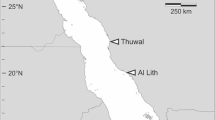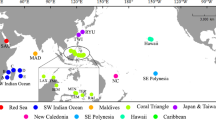Abstract
Symbiotic relationships on coral reefs involving benthic hosts other than scleractinian corals have been poorly investigated. The hydroid Pteroclava krempfi is a widespread species known to be mainly associated with alcyonacean octocorals in the Indo-Pacific. In the present study, P. krempfi was discovered in association with octocorals of the genus Antillogorgia (Gorgoniidae) at two localities in the Caribbean Sea (St. Eustatius in the eastern Caribbean and Bocas del Toro in the western part), updating its host range with an additional genus and family. The Caribbean specimens showed no morphological differences and the shape of their polyps was consistent with the original P. krempfi description. A multi-locus phylogeny reconstruction of the P. krempfi species complex based on both mitochondrial and nuclear loci revealed three separate molecular clades. Two of them were composed of P. krempfi associated with the families Plexauridae and Alcyoniidae from the Maldives, whereas a new highly supported molecular lineage included all Caribbean specimens of P. krempfi associated with the family Gorgoniidae. These three divergent molecular clades represent distinct cryptic taxa within the P. krempfi species complex, in which the main interspecific difference consists of their host families.



Similar content being viewed by others
References
Appeltans W, Ahyong ST, Anderson G, Angel MV, Artois T, Bailly N et al (2012) The magnitude of global marine species diversity. Curr Biol 22:2189–2202. doi:10.1016/j.cub.2012.09.036
Bickford D, Lohman DJ, Sodhi NS, Ng PKL, Meier R, Winker K et al (2007) Cryptic species as a window on diversity and conservation. Trends Ecol Evol 22:148–155. doi:10.1016/j.tree.2006.11.004
Billard A (1919) Note sur une espèce nouvelle d’hydroïde gymnoblastique (Clava krempfi), parasite d’un Alcyonaire. Bull Mus Natl Hist Nat 25:187–188
Boero F, Bouillon J, Gravier-Bonnet N (1995) The life cycle of Pteroclava krempfi (Cnidaria, Hydrozoa, Cladocorynidae), with notes on Asyncoryne philippina (Asyncorynidae). Sci Mar 59:65–76
Boero F, Bouillon J, Gravili C (2000) A survey of Zanclea, Halocoryne and Zanclella (Cnidaria, Hydrozoa, Anthomedusae, Zancleidae) with description of new species. Ital J Zool 67: 93–124
Bos AR, Hoeksema BW (2015) Cryptobenthic fishes and co-inhabiting shrimps associated with the mushroom coral Heliofungia actiniformis (Fungiidae) in the Davao Gulf, Philippines. Environ Biol Fish 98:1479–1489. doi:10.1007/s10641-014-0374-0
Bridge D, Cunningham CW, DeSalle R, Buss LW (1995) Class-level relationships in the phylum Cnidaria: molecular and morphological evidence. Mol Biol Evol 12:679–689
Castresana J (2000) Selection of conserved blocks from multiple alignments for their use in phylogenetic analysis. Mol Biol Evol 17:540–552
Collins AG (2000) Towards understanding the phylogenetic history of Hydrozoa: hypothesis testing with 18S gene sequence data. Sci Mar 64:5–22. doi:10.3989/scimar.2000.64s15
Collins AG, Schuchert P, Marques AC, Jankowski T, Medina M, Schierwater B (2006) Medusozoan phylogeny and character evolution clarified by new large and small subunit rDNA data and an assessment of the utility of phylogenetic mixture models. Syst Biol 55:97–115. doi:10.1080/10635150500433615
Fabricius KE, Alderslade P (2001) Soft corals and sea fans: a comprehensive guide to the tropical shallow water genera of the central-west Pacific, the Indian Ocean and the Red Sea. Australian Institute of Marine Science (AIMS), Townsville
Fisher R, O’Leary RA, Low-Choy S, Mengersen K, Knowlton N, Brainard RE et al (2015) Species richness on coral reefs and the pursuit of convergent global estimates. Curr Biol 25:500–505. doi:10.1016/j.cub.2014.12.022
Folmer O, Black M, Hoeh W, Lutz R, Vrijenhoek R (1994) DNA primers for amplification of mitochondrial cytochrome c oxidase subunit I from diverse metazoan invertebrates. Mol Mar Biol Biotechnol 3:294–299
Fontana S, Keshavmurthy S, Hsieh HJ, Denis V, Kuo C-Y, Hsu C-M et al (2012) Molecular evidence shows low species diversity of coral-associated hydroids in Acropora corals. PLoS One 7:e50130. doi:10.1371/journal.pone.0050130
Gittenberger A, Gittenberger E (2011) Cryptic, adaptive radiation of endoparasitic snails: sibling species of Leptoconchus (Gastropoda: Coralliophilidae) in corals. Org Divers Evol 11:21–41. doi:10.1007/s13127-011-0039-1
Hirose M, Hirose E (2011) A new species of Zanclea (Cnidaria: Hydrozoa) associated with scleractinian corals from Okinawa, Japan. J Mar Biol Assoc UK 92:877–884. doi:10.1017/S0025315411001238
Hoeksema BW, Fransen CHJM (2011) Space partitioning by symbiotic shrimp species cohabitating in the mushroom coral Heliofungia actiniformis at Semporna, eastern Sabah. Coral Reefs 30:519. doi:10.1007/s00338-011-0736-4
Hoeksema BW, Van der Meij SET, Fransen CHJM (2012) The mushroom coral as a habitat. J Mar Biol Assoc UK 92:647–663. doi:10.1017/S0025315411001445
Katoh K, Standley DM (2013) MAFFT multiple sequence alignment software version 7: improvements in performance and usability. Mol Biol Evol 30:772–780. doi:10.1093/molbev/mst010
Knowlton N (2000) Molecular genetic analyses of species boundaries in the sea. Hydrobiologia 420:73–90. doi:10.1023/A:1003933603879
Lanfear R, Calcott B, Ho SY, Guindon S (2012) PartitionFinder: combined selection of partitioning schemes and substitution models for phylogenetic analyses. Mol Biol Evol 29:1695–1701. doi:10.1093/molbev/mss020
Maggioni D, Montano S, Seveso D, Galli P (2016) Molecular evidence for cryptic species in Pteroclava krempfi (Hydrozoa, Cladocorynidae) living in association with alcyonaceans. Syst Biodivers. doi:10.1080/14772000.2016.1170735
Medlin L, Elwood HJ, Stickel S, Sogin ML (1988) The characterization of enzymatically amplified eukaryotic 16S-like rRNA-coding regions. Gene 71:491–499
Miglietta MP, Schuchert P, Cunningham CW (2009) Reconciling genealogical and morphological species in a worldwide study of the Family Hydractiniidae (Cnidaria, Hydrozoa). Zool Scr 38:403–430. doi:10.1111/j.1463-6409.2008.00376.x
Montano S, Maggioni D, Galli P, Seveso D, Puce S (2013) Zanclea–coral association: new records from Maldives. Coral Reefs 32:701. doi:10.1007/s00338-013-1023-3
Montano S, Galli P, Maggioni D, Seveso D, Puce S (2014) First record of coral-associated Zanclea (Hydrozoa, Zancleidae) from the Red Sea. Mar Biodivers 44:581–584. doi:10.1007/s12526-014-0207-6
Montano S, Arrigoni R, Pica D, Maggioni D, Puce S (2015a) New insights into the symbiosis between Zanclea (Cnidaria, Hydrozoa) and scleractinians. Zool Scr 44:92–105. doi:10.1111/zsc.12081
Montano S, Maggioni D, Arrigoni R, Seveso D, Puce S, Galli P (2015b) The hidden diversity of Zanclea associated with scleractinians revealed by molecular data. PLoS One 10:e0133084. doi:10.1371/journal.pone.0133084
Montano S, Seveso D, Galli P, Puce S, Hoeksema BW (2015c) Mushroom corals as newly recorded hosts of the hydrozoan symbiont Zanclea sp. Mar Biol Res 11:773–779. doi:10.1080/17451000.2015.1009467
Montano S, Galli P, Hoeksema BW (2016) First record from the Atlantic: a Zanclea-scleractinian association at St. Eustatius, Dutch Caribbean. Mar Biodivers. doi:10.1007/s12526-015-0432-7
Moura CJ, Harris DJ, Cunha MR, Rogers AD (2008) DNA barcoding reveals cryptic diversity in marine hydroids (Cnidaria, Hydrozoa) from coastal and deep-sea environments. Zool Scr 37:93–108. doi:10.1111/j.1463-6409.2007.00312.x
Moura CJ, Cunha MR, Porteiro FM, Rogers AD (2012) Polyphyly and cryptic diversity in the hydrozoan families Lafoeidae and Hebellidae (Cnidaria: Hydrozoa). Invertebr Syst 25:454–470. doi:10.1071/IS11045
Pantos O, Bythell JC (2010) A novel reef coral symbiosis. Coral Reefs 29:761–770. doi:10.1007/s00338-010-0622-5
Puce S, Cerrano C, Di Camillo CG, Bavestrello G (2008a) Hydroidomedusae (Cnidaria: Hydrozoa) symbiotic radiation. J Mar Biol Assoc UK 88:1715–1721. doi:10.1017/S0025315408002233
Puce S, Di Camillo CG, Bavestrello G (2008b) Hydroids symbiotic with octocorals from the Sulawesi Sea, Indonesia. J Mar Biol Assoc UK 88:1643–1654. doi:10.1017/S0025315408001094
Reaka-Kudla ML (1997) The global biodiversity of coral reefs: a comparison with rain forests. In: Reaka-Kudla ML, Wilson DE, Wilson EO (eds) Biodiversity II: understanding and protecting our natural resources. Joseph Henry/National Academy Press, Washington DC, pp 83–108
Ronquist F, Teslenko M, van der Mark P, Ayres DL, Darling A, Höhna S et al (2012) MrBayes 3.2: efficient Bayesian phylogenetic inference and model choice across a large model space. Syst Biol 61:539–542. doi:10.1093/sysbio/sys029
Ruppert EE, Fox RS, Barnes RD (2004) Invertebrate zoology: a functional evolutionary approach, 7th edn. Thomson-Brooks/Cole, Belmont
Schuchert P (2014) High genetic diversity in the hydroid Plumularia setacea: a multitude of cryptic species or extensive population subdivision? Mol Phylogenet Evol 76:1–9. doi:10.1016/j.ympev.2014.02.020
Seveso D, Montano S, Pica D, Maggioni D, Galli P, Allevi V et al (2015) Pteroclava krempfi-octocoral symbiosis: new information from the Indian Ocean and the Red Sea. Mar Biodivers 46:483–487. doi:10.1007/s12526-015-0368-y
Stella JS, Pratchett MS, Hutchings PA, Jones GP (2011) Coral-associated invertebrates: diversity, ecological importance and vulnerability to disturbance. Oceanogr Mar Biol Annu Rev 49:43–116. doi:10.1201/b11009-3
Talavera G, Castresana J (2007) Improvement of phylogenies after removing divergent and ambiguously aligned blocks from protein sequence alignments. Syst Biol 56:564–577. doi:10.1080/10635150701472164
Tamura K, Stecher G, Peterson D, Filipski A, Kumar S (2013) MEGA6: molecular evolutionary genetics analysis version 6.0. Mol Biol Evol 30:2725–2729. doi:10.1093/molbev/mst197
Varela C (2010) Tres nuevos registros de hidrozoos (Cnidaria: Hydroidomedusae), para Cuba. Rev Invest Mar 31:104–105
Williams GC, Chen JY (2012) Resurrection of the octocorallian genus Antillogorgia for Caribbean species previously assigned to Pseudopterogorgia, and a taxonomic assessment of the relationship of these genera with Leptogorgia (Cnidaria, Anthozoa, Gorgoniidae). Zootaxa 3505:39–52
Zheng L, He J, Lin Y, Cao W, Zhang W (2014) 16S rRNA is a better choice than COI for DNA barcoding hydrozoans in the coastal waters of China. Acta Oceanol Sin 33:55–76. doi:10.1007/s13131-014-0415-8
Zietara MS, Arndt A, Geets A, Hellemans B, Volckaert FA (2000) The nuclear rDNA region of Gyrodactylus arcuatus and G. branchicus (Monogenea: Gyrodactylidae). J Parasitol 86:1368–1373. doi:10.1645/0022-3395(2000)086[1368:TNRROG]2.0.CO;2
Zwickl DJ (2006) GARLI: genetic algorithm for rapid likelihood inference. Home page at: http://www.bio.utexas.edu/faculty/antisense/garli/garli.html
Acknowledgements
Fieldwork participation of the first author was funded through a Martin Fellowship from Naturalis Biodiversity Center. St. Eustatius Marine Parks (STENAPA), Caribbean Netherlands Science Institute (CNSI) and Scubaqua Dive Centre provided logistic support. The authors wish to thank the staff of the Marine Research and High Education Center (MaRHE Center) in Magodhoo Island (Maldives). Finally, we are very grateful to the three anonymous reviewers whose constructive comments helped in improving the manuscript.
Author information
Authors and Affiliations
Corresponding author
Additional information
Communicated by J. D. Reimer
Electronic supplementary material
Below is the link to the electronic supplementary material.
Fig. S1
(PDF 1385 kb)
Rights and permissions
About this article
Cite this article
Montano, S., Maggioni, D., Galli, P. et al. A cryptic species in the Pteroclava krempfi species complex (Hydrozoa, Cladocorynidae) revealed in the Caribbean. Mar Biodiv 47, 83–89 (2017). https://doi.org/10.1007/s12526-016-0555-5
Received:
Revised:
Accepted:
Published:
Issue Date:
DOI: https://doi.org/10.1007/s12526-016-0555-5




